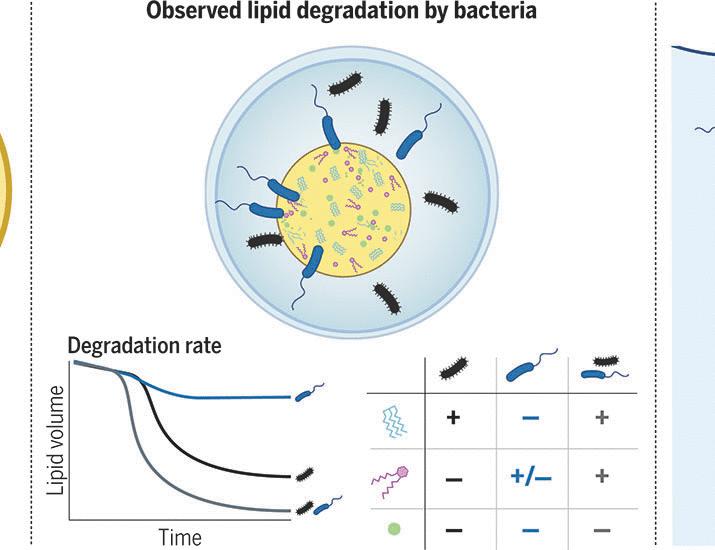
Submission historyReceived: 8 December 2023Accepted: 9 July 2024Published in print: 13 September 2024AcknowledgmentsWe thank R. Naisbit for help with editing the manuscript, N. Renier and C. Park for figure production, H. Holm and the EXPORTS Program for lipidomic analysis and sampling in the North Atlantic, and K. Longnecker for assistance with image analysis. We acknowledge the NCMA (Bigelow Laboratory, Maine, USA) for large-scale growth and harvest of P. tricornutum cells.Funding: This research was funded by a grant from the Marine Microbiology Initiative division of the Gordon and Betty Moore Foundation (GBMF5073 to B.A.S.V.M. and R.S.). B.A.S.V.M. was also supported by grants from the Simons Foundation (721229) and the National Science Foundation (OCE-1756254 and OCE-2022597). T.M and B.A.S.V.M. were supported by a National Science Foundation grant (OCE-0825407). R.S. was supported by grants from Gordon and Betty Moore Foundation Symbiosis in Aquatic Systems Investigator Award (GBMF9197; https://doi.org/10.37807/GBMF9197), the Simons Foundation through the Principles of Microbial Ecosystems (PriME) collaboration (grant 542395) and the Swiss National Science Foundation, National Centre of Competence in Research (NCCR) Microbiomes (51NF40_180575). L.B. was supported by grants from the Independent Research Fund Denmark (DFF-1323-00747 and DFF-1325-00069), the Swedish Research Council (2019-04401), the Novo-Nordisk Foundation (NNF22OC0079370) and the Science for Life Laboratory. J.J.H. has been supported by a Canada Research Chair from the Canadian Institutes for Health Research (CIHR), the CIHR Canadian Microbiome Initiative 2: Research Core, a Discovery Grant from the Natural Sciences and Engineering Research Council of Canada, and the Canada Foundation for Innovation. F.J.P. has received funding from the European Union’s Horizon 2020 research and innovation programme under Marie Sklodowska-Curie grant agreement 798411. U.A. was supported by funding from the European Molecular Biology Organization (EMBO; ALTF 1109-2016) and the Human Frontier Science Program (HFSP; LT001209/2017).Author contributions: L.B., U.A., J.E.H., B.A.S.V.M., and R.S. designed the research. L.B., U.A., Y.Y., and S.S. conducted microbiology and microscopy experiments. J.E.H, H.F.F., and B.A.S.V.M conducted chemical extractions and lipidomic experiments. H.A. and J.J.H. conducted molecular experiments. T.M. provided access to bacterial collections. L.B., U.A., J.E.H., D.P.L., F.J.P., V.I.F., H.F.F., H.A., J.J.H., S.S., and B.A.S.V.M analyzed and interpreted data. L.B., B.A.S.V.M., and R.S. provided funding acquisition, project administration, and resources. D.P.L, V.I.F., F.J.P., and B.A.S.V.M. developed modeling approaches. L.B., U.A., S.S., F.J.P., B.A.S.V.M., and R.S. wrote the paper.Competing interests: R.S. is co-founder and Chief Scientific Officer of PhAST Diagnostics, a company whose focus is entirely unrelated to this work. T.M. is a member of the advisory board for the Tire Industry Project which is part of the World Business Council for Sustainable Development. T.M. is also co-founder of a small biotech company: Solarea Bio, and a consultant for Change Foods, a small biotech company in Palo Alto CA. Honoraria and common stock are all less than USD $5000 in value per year.Data availability: All data presented in this paper and associated supplementary materials have been deposited in Dryad (47). This includes data from all figures as well as supplementary movies and tables. A CSV file containing patristic distance matrix values for the phylogenetic tree is also available from that link. The complete P. zhaodongensis (Pz15), M. adhaerens HP15-B (Ma1), P. shioyasakiensis (Psh20), and R. pomeroyi DSS-3-B (Rp3) genomes were deposited in NCBI Genbank with accessions CP076683.1/CP076684.1, CP076686.1, CP076681.1/CP076682.1, and CP076685.1, respectively, corresponding to BioSamples SAMN19272545, SAMN19272548, SAMN19272546, and SAMN19272547, respectively. Isolates, strains, and plasmids are available on request to the corresponding authors. Sequencing data have been deposited with links to BioProject accession number PRJNA731154 in the National Center for Biotechnology Information (NCBI) BioProject database (https://www.ncbi.nlm.nih.gov/bioproject/). The datasets and representative videos generated and analyzed during the study are available in the Supplementary Information of the paper. The code used for quantifying lipid degradation through chloropigment quenching is also available on Dryad (47). The code for the model of bacterial degradation of lipids is available on Zenodo (48).
